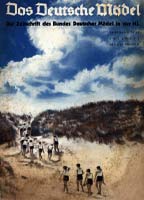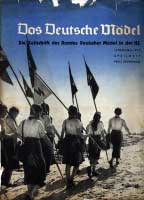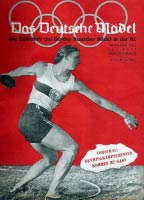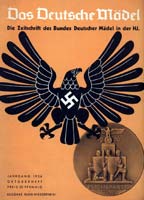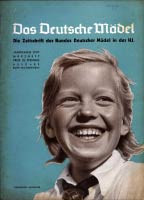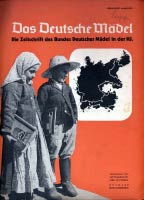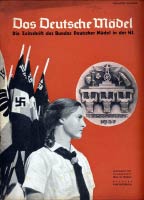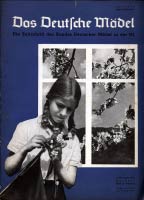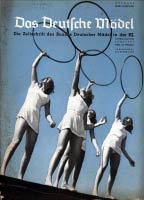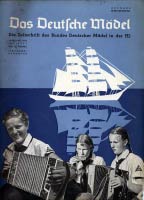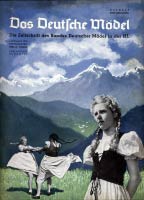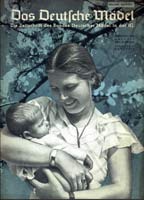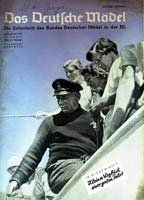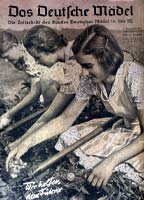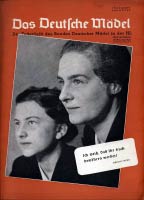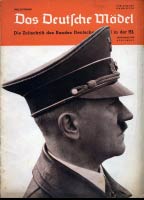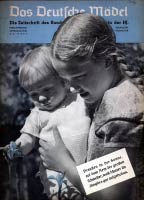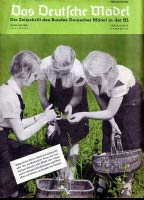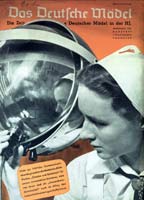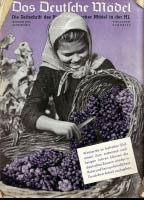Das Deutsche Mädel (The German Girl) was the official monthly magazine for German girls between the ages of 10 – 18 who participated in the League of German Girls. From February 1933, the magazine was initially published under the title “Das Deutsche Mädel Federal Letters of the BDM” or “Federal Letters of the Bund Deutscher Mädel in the Hitler Youth.” In 1934, the name changed to “Das Deutsche Mädel – The Magazine of the Bund Deutscher Mädel in der HJ.”
Monthly publications started in February 1933 until December 1942. From January 1943 onward, the magazines were published bi-monthly until September 1944.
Unlike the adventure orientation of “Der Pimpf,” intended for Hitler Youth, “Das Deutsche Mädel” urged hiking, tending the wounded, hard work in factories, and preparing for motherhood. On the other hand, in contrast to the woman’s magazine “NS-Frauen-Warte,” it lay far more emphasis on the strong and active German woman featuring health and education, service and sports to name a few. Famous women depicted include doctors, athletes, poets, chemists, and pilots. Articles include a speech by Jutta Rüdiger when she was appointed to lead the League of German Girls, stories directed to the 10-year-old girls who joined the Jungmädelbund of their duties to Germany, and a story of how young girls had ensured that a dead father’s promise to his son was fulfilled.
The Reichsjugendführer, Baldur von Schirach, acted as the publisher. In 1933, Lydia Gottschewsky, Irmgard von Maltzahn, and Gerda Zimmermann were successively responsible as editors. From 1934, Hilde Munske became the Chief Editor. During this time, Munske was also the BDM office secretary in the “Office for Press and Propaganda of the Reich Youth Leadership.” According to the imprint, Lydia Schürer-Stolle was responsible for compiling the Jungmädel section of the magazine. At the same time, Stolle was a Jungmädel consultant for the Reichsjugendführung.
Since its inception, BDM Gau leaders and similar officials initially wrote the articles. From 1934 onward, the “girls” (allegedly) wrote letters and articles from the entire “Reich.” This thinking would contribute to the “participatory character” of the girls’ magazine and thus become more attractive for the target audience.
In addition to articles about the National Socialist organizations and the like, “The German Girl” magazine mainly consisted of articles conceived as reports on experiences, song texts, poems, and large-scale photographs. Stories about the German farmers, the importance of nature and preserving the land, and features of large cities, made the magazine interesting and attractive for any girl reading it.
9” x 12” with color illustrated cover, normally 32 pages with photos and drawings, as well as a double-sided classified section. Writing is in Fraktur. The content and articles are vast, diversified, and include women in German working life, worries of our grandmothers, beauty and form, comradeship, young children stories about growing up, giants, the three piglets, and world-views.
Other intimate stories include the women’s soul of the farm, cultural life under Adolf Hitler, and the economic boom under National Socialism. Articles written also include the important work of the Hitler Youth and the BDM within the community. Politically and culturally trained BDM leaders, National Socialist press, German youth literature, book recommendations, and young German people in sports, leisure activities, current fashions, Reich youth leaders, and physical training all inspired the girls to become productive members of society.




